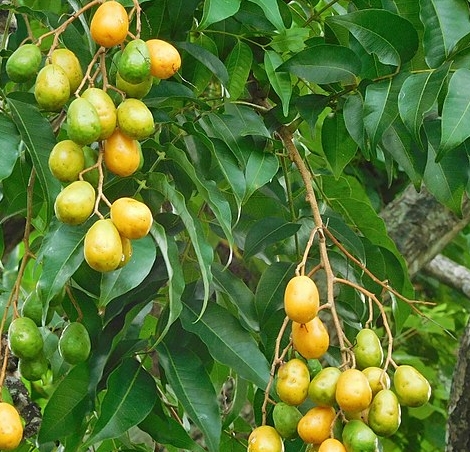Spondias mombin

|
|
Spondias mombin Common Names: Hog plum, yellow mombin, caja Scientific
Classification Kingdom: Plantae Clade: Tracheophytes Clade: Angiosperms Order: Sapindales Family: Anacardiaceae Genus: Spondias Species: S. mombin Binomial Name: Spondias mombin L. Synonyms: Spondias lutea L., Spondias mombin var. glabra Griseb. Morphological Description Spondias mombin, commonly known as hog plum or yellow mombin, is a deciduous tree
that can grow to heights of 15–30 meters, occasionally reaching 40 meters in
optimal conditions (Tropical Plants Database, 2024). The trunk is covered with
grayish-brown, thick, fissured bark often bearing blunt, spine-like
projections, and can reach diameters of 60–75 cm (Gilman & Watson, 1994).
Its compound leaves are alternately arranged, pinnate, and measure 20–50 cm
long, with 5–19 elliptic to oblong leaflets, each 5–15 cm long and 2–5 cm wide,
featuring serrated margins and a glossy upper surface (Kew Science, 2024). The
tree produces small, yellow-green flowers, 4–6 mm in diameter, borne in large,
terminal panicles up to 40 cm long. The oval-shaped fruits, 3–5 cm long and 2–3
cm wide, turn bright yellow when ripe, encasing a fibrous, juicy, acidic pulp
around a single large seed, 2–3 cm long (Orumwensodia et al., 2021). Distribution and Habitat Native to the tropical
Americas, including Central America, northern South America, and the West
Indies, Spondias mombin has been naturalized across sub-Saharan Africa (e.g.,
Nigeria, Ghana), India, Southeast Asia (e.g., Malaysia, Philippines), and the
Caribbean (Kew Science, 2024; CABI, 2024). It thrives in wet tropical climates
with annual rainfall of 1,000–2,500 mm and temperatures of 20–32°C, often found
in secondary forests, riverbanks, roadsides, and cultivated areas at elevations
up to 1,200 meters (Gilman & Watson, 1994). The tree prefers well-drained,
loamy or sandy soils with a pH of 5.0–6.5, though it tolerates occasional
flooding and poor soils, reflecting its adaptability (Tropical Plants Database,
2024). Ethnopharmacology Spondias mombin is widely used in traditional medicine for its extensive
therapeutic benefits. The leaves, bark, fruit, and roots are used in treating a
variety of ailments. Pharmacological studies have shown that S. mombin
possesses antioxidant, anti-inflammatory, antimicrobial, analgesic,
antidiabetic, and hepatoprotective activities. The leaves and bark extracts are
commonly used to treat gastrointestinal disorders, wounds, infections, and
menstrual issues. Its antioxidant activity is attributed to the presence of
flavonoids, tannins, and phenolic compounds, which scavenge free radicals and
reduce oxidative stress. Additionally, extracts from the plant have
demonstrated blood glucose-lowering effects in diabetic rats and protective
effects against liver damage induced by toxins. Traditional applications also
include use as a sedative, for treating convulsions, and for boosting fertility
in some African communities. Despite its wide ethnomedicinal use, more clinical
research is needed to confirm its efficacy and safety in humans. · Digestive Disorders: In Nigeria, leaf infusions treat diarrhea
and dysentery; methanol extracts reduced intestinal motility by 40% in rats,
linked to flavonoids and tannins (Nworu et al., 2011). · Antimicrobial Activity: In Brazil, bark decoctions combat
infections; leaf extracts showed a minimum inhibitory concentration (MIC) of
125 μg/mL against Staphylococcus aureus and Escherichia coli, due to ellagic acid and gallic acid (Cabral et al., 2016). · Antidiabetic Effects: In Trinidad, fruit pulp manages diabetes
he inhibitory effects of solvent-partitioned
fractions of Spondias mombin on α-amylase and α-glucosidase enzymes. The study
found that these fractions could effectively inhibit these enzymes, which are
key in carbohydrate digestion and glucose absorption, suggesting a mechanism
for its antidiabetic activity (Ojo et al., 2018). · Anti-inflammatory and Analgesic: methanolic leaf extracts of Spondias
mombin significantly reduced inflammation in Wistar rats. The study attributed
this effect to the suppression of pro-inflammatory mediators such as tumor
necrosis factor-alpha (TNF-α) and nitric oxide. (Nworu et al., 2011). These applications are
supported by over 102 identified compounds, including quercetin and chlorogenic
acid, enhancing its antimicrobial, antioxidant, and cytotoxic potential (Ogunro
et al., 2022). ⚠ Toxicity Profile: Spondias mombin is generally safe in traditional doses,
but excessive consumption of unripe fruits or leaves may cause toxicity due to
cyanogenic glycosides and high tannin levels. Acute studies in rats showed no
mortality at 5,000 mg/kg of leaf extract, though doses above 1,000 mg/kg caused
mild gastrointestinal distress (Orumwensodia et al., 2021). Prolonged use may
irritate mucous membranes, necessitating moderation and proper preparation
(Tropical Plants Database, 2024). Additional Uses · Nutritional Benefits: Fruits provide 48–60 mg/100 g vitamin C,
20–30 mg/100 g calcium, and 1.5–2 mg/100 g iron, used fresh or in juices, jams,
and wines (Tiburski et al., 2011). · Timber and Materials: The soft wood (density 0.35–0.45 g/cm³) is
used for crates and carvings, while bark yields a yellow dye (Gilman &
Watson, 1994). · Agricultural Use: Leaves serve as fodder for goats and
cattle, and the tree’s canopy provides shade in agroforestry systems (CABI,
2024). References
External Links More Pictures |
|
| Compounds of Spondias mombin |
|
| References |